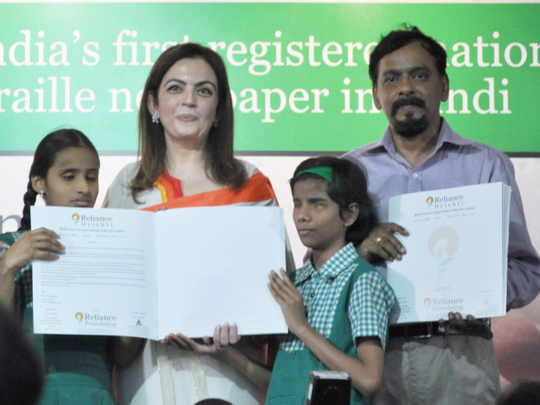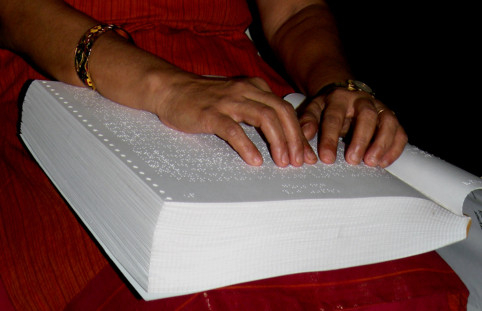
It all started in 1993, when Swagat Thorat did his first project with the visually challenged: a documentary about two schools for the blind in Pune. Later, in 1997, he directed a play in Marathi, “Swatantryachi Yashogatha” (Glorious Story of Independence), for India’s 50th Independence Day with 88 blind artistes from two schools. The performance found a mention in “Guinness World Records” and the “Limca Book of Records” for having the largest number of visually impaired artistes. He even produced a live audio-drama based on Helen Keller’s biography.
During the interactions with the blind for these projects, Thorat learnt that they wanted to read but there were just not enough books in Braille. He could not ignore the need, as he had always been fascinated by the world of the visually impaired and wanted to know what it feels like to be one of them. But to write for them, Thorat explained in an interview with Weekend Review, he had to understand their world devoid of light and the dilemmas they faced:
What made you start India’s first Braille magazine?
As child I was always fascinated by the blind. Every day on my way back from school, I used to run into a group of blind astrologers. I would stop and chat with them for few minutes. Their life experiences fascinated me. I wanted to know how they carry the darkness with them. On many occasions, I blindfolded myself to be in their world. I realised we had forgotten to use so many of our senses.
While doing the show, I travelled with these children and observed that their discussions revolved around things that they had read. Back in 1998, there were very few Braille books available. I realised that these children wanted to read more. There was a need. Television and radio were there, but the very absence of reading material made them feel isolated. Their imagination is far stronger than in others, but these mediums did not allow them to dream or create a space for themselves.
But writing for the blind was very different from writing for the sighted. To write for the blind you would have to think like one of them. Suppose you are writing a recipe for them: “Fry the onions until golden brown” will become “fry for two to three minutes”. It is simply amazing to learn about their interpretations of colour, size, shape — it is an eye opener. The sighted will never be able to think like that.
During Diwali (festival of lights), that year, we first came out with a special issue of Sparshdnyan in Braille. Diwali special issues are an integral part of Marathi literary culture — every publication has one — but there was nothing in Braille. People then started writing to demand more than just an annual publication and hence the fortnightly magazine came into being.
What were the challenges you faced in starting such a publication?
The biggest hurdle was to convince people that the blind needed a newspaper. When we first started, even parents of the blind asked why their children need a newspaper. Apart from that, there were the usual problem of funds, but many sighted people wanted to get involved in Sparshdnyan, and donated generously. This kept us going. Many of them learnt to read the Braille from me. It is heartening to know that my work has helped change the perspective of the sighted about the visually challenged.
I invested more than Rs400,000 (Dh24,134) on procuring Braille printing machine and renting an office space in Mumbai. This investment helped create the first bimonthly issue of Sparshdnyan, which was published on February 15, 2008. We started with 100 copies and, in these six years, have brought it up to 430 copies per issue. Our subscribers re-circulate the issues to others and our readership of more than twenty-four thousand. Most of the copies are gifted to schools for the blind and NGOs working for the blind in the 31 districts of Maharashtra. Since most of my journalist friends do not charge us for writing, we are able to provide such a large variety of articles. Also my family members help me in production, whereby I am able to keep the cost low.
We have a scheme where people can donate Rs 1200 towards the annual subscription for those individuals who can’t afford it themselves. We have 3,000 such readers on the waiting list.
But until now we haven’t got a single advertisement. We must have created a record of being the only magazine running for six years without a single advertisement. Companies do not realise that these people too are consumers and need everything that we need.
Tell us about Drishti.
Reliance Drishti is the first-ever monthly Hindi newsmagazine published in Braille and circulated all over India. It is entirely funded by Reliance Foundation, a charity wing of the Reliance Group. It was launched in May last year by Mrs Nita Ambani, chairperson of the foundation. I edit the magazine, along with Sparshdnyan, and my entire team works on it. We even have a reporter who is partially blind, which helps as she is able to give us a much better understanding of their world and their needs.
Reliance Drishti is dream come true for me, since Sparshdnyan is published in Marathi and many people all over the country wanted a magazine published in Braille in the national language. It has only become possible since Reliance Foundation funded it. We publish around 900 copies every month, which are donated to organisations for the blind. Every copy is read by at least 80 people.
What kind of stories you publish in the magazines?
We publish everything that is in the mainstream media. Both the publications have articles on politics, social and governance issues, to health-related articles, to profiles on famous personalities. We also publish articles on cooking, yoga and all other aspects of life. Our readers may be blind, but their needs are just like yours and mine.
We also have an editorial page, just like any other newspaper, where we present views on various issues that affect our country, such as corruption, governance and politics. However, stories relating to astrology, cricket and crime are not included in Sparshdnyan, though news about cricket is published in Drishti. I don’t believe in fate but in hard work and experience, hence we leave astrology aside. Cricket is all over the broadcast media. As for crime stories, they often even affect the sighted emotionally, so imagine the impact it will have on the blind, many of whom battle depression throughout their lives. Hence, we leave them out. Both the magazines provide the visually challenged with material they can intellectually engage with. It started at a time when people felt the visually challenged do not need higher education or intellectual stimulation.
Have you started any other programme for the visually challenged?
We have conceptualised and designed Braille stickers to use in lifts. These stickers help visually challenged people to operate lifts on their own. These stickers are now used in more than 100 lifts all over Mumbai. This number is increasing day by day and people are getting sensitised about the needs of the blind. We have also designed and developed the concept of Braille table calendar.
The whole idea behind the magazines or stickers or calendars is to make the visually challenged person self-dependent. For the blind, even day-to-day tasks which we take for granted are a challenge. They demand freedom.
What has been the biggest satisfaction in publishing the magazine?
We get about 600 to 700 letters-to-the-editor every month. We have readers from 10- to 80-year-olds. I think more than half are between 18 and 35. When a blind person writes to us and shares their feelings about the magazine, it makes me happy. A lot of people have also got jobs reading our magazine, since our annual issue is only on general knowledge. Blind people do not forget what they learn by touching, hence we call our magazine Sparshdnyan.
Archisman Dinda is a journalist based in Kolkata.



